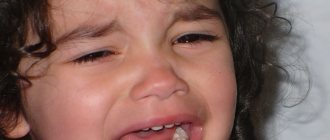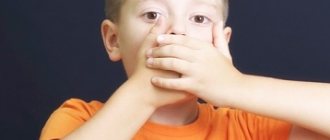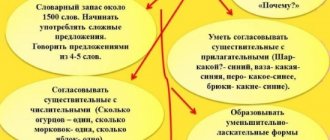Prognosis of motor alalia
In a child, the speed of development of higher mental functions (memory, attention, logic, thinking, intelligence, etc.) depends on age. The younger the child, the faster he develops intellectually. We, adults, in the absolute majority can only gain knowledge and improve skills. Science knows of no cases in which an ordinary uneducated worker or peasant was able to turn into a great doctor.
Speech is one of the ways of understanding the world, which a child begins to use from the age of one to one and a half years. And the absence of speech begins to slow down the rate of development of the child’s intelligence. Initially, compensatory, motor alaliks at 2-3 years of age have higher intelligence than their peers - they understand everything, but do not speak - this is what they say about them. But in the future, the lack of speech begins to inhibit the development of non-verbal intelligence. This usually occurs at 3-4 years, and by 5 years their intellectual underdevelopment becomes visible to everyone. And for this reason, at the age of 4-5 years, psychologists rightly diagnose them with mental retardation (mental retardation). Speech therapy textbooks on motor alalia always say that such children have primarily preserved intelligence at an early age, and if not treated (lack of classes with a speech therapist), intelligence is secondarily reduced.
The same thing happens in the absence of speech, even in healthy children. All known cases of “Mowgli”, when a human child was raised by animals, indicate that these children could not master speech in full and have a severe, irreparable delay in intellectual development.
From a textbook on the history of speech therapy: - In ancient times (many centuries ago), when human life was worth nothing, they decided to conduct an experiment in India. They took babies from different nations, put them in one room and didn’t talk to them until they were 6 years old, at all. And then we tried to teach them to speak. It was not possible to form speech with any child from different nations. And I don’t understand why, in our enlightened times, some parents conduct such experiments on their children - “he doesn’t speak, it’s okay, then he’ll talk.”
On the Internet, stories are often cited as examples about a father or grandfather who spoke late and now works great at a factory. Well, firstly, most of these stories are not true, since the people around are non-specialists and the inability to tell any poem by A.S. Pushkin. is perceived as an inability to speak. I regularly undergo examinations, during which nervous parents find out that everything is fine with their child. Since at this age a child should have such speech, and they do not need a speech therapist. And, secondly, when these cases are true, think about what this person would become if speech therapists had formed his speech in a timely manner. Perhaps society has lost a great scientist and inventor in him; maybe he would now invent a cure for incurable diseases or create spaceships that will fly to other stars. And now he's just a mechanic. This is not a reason to be proud of the damage parents caused to their child’s intellect by not turning to a specialist in time.
Speech and intelligence are interconnected. Lack of speech at 2 years old should alert parents. You can't wait. Every day without speech damages a child's intelligence. At the age of 5-6 years, almost all children with motor alalia are diagnosed with decreased intelligence.
How to make sure of the diagnosis
Diagnosis of motor alalia in children is possible from 3 years of age. Until this age, its symptoms can be noticed, but in most cases this is only a reason for parents to be wary and an opportunity for the doctor to talk about the likelihood of a diagnosis.
The examination begins with a visit to a neurologist. He makes a preliminary diagnosis. In the differential diagnosis of motor alalia, it is necessary to exclude:
- sensory alalia (speech neurologist);
- hearing impairment (otorhinolaryngologist or audiologist);
- autism, intellectual development disorders (psychiatrist).
Delayed speech development, dysarthria, and aphasia are ruled out by a speech therapist. Based on the data obtained by this specialist and doctors, as well as the results of the examinations they prescribed, the neuropsychologist determines the level and location of brain dysfunction. As a result, the diagnosis of motor alalia is confirmed or refuted.
What is sensory alalia
Sensory (impressive) alalia is a severe form of speech development, in which both understanding and speaking suffer, and a number of symptoms of the motor type of the disease are observed. According to medical statistics, in the total number of children suffering from problems with the speech apparatus, the motor type accounts for 90% of cases, while the sensory type accounts for only the remaining 10%.
Sensory alalia is a violation of a child’s understanding of the speech of others. Expressive speech (the ability to speak coherently) cannot develop in a child under such circumstances. Some believe that sensory alalia is an inability to speak due to a violation of the articulatory apparatus. However, the speech impairment here is secondary, that is, due to a lack of understanding of the speech of others, due to problems with phonemic hearing.
A child with good hearing cannot put into words the sounds that he hears from adults or pronounces himself. Therefore, he is unable to reproduce them.
With this type, damage or underdevelopment of the speech-hearing analyzer is observed. This leads to serious disruptions in analytical and synthetic activities. The sounds that the child hears are not different to him. He is unable to recognize words or even individual sounds or syllables.
Causes of sensory alalia
This disorder is caused by lesions of the brain, namely certain zones located in the cortical part of it, which are responsible for the speech apparatus, speech analysis, and understanding of sounds. The main factors that can lead to this are:
- Fetal pathologies that appear during pregnancy. Gestation can be complicated by hypoxia, infections, and malnutrition. Disturbances in the development of the fetal central nervous system may occur when consuming alcohol or drugs.
- Disturbance of the central nervous system during childbirth. The fetus can suffer damage to the nervous system if the obstetrician acts incorrectly. During childbirth, the baby may suffer a head injury.
- Diseases in the postnatal period. They can occur in the first years of the baby.
There are other reasons that can also cause such a speech disorder. Diagnosis can only be made after a comprehensive examination of the child. The baby should be examined by a speech therapist, pediatrician, neurologist, child psychologist, and otolaryngologist.
How to identify sensory alalia
To assess the state of the brain of a child who is suspected of having alalia, it is necessary to conduct an MRI of the brain and an EEG. All these research methods are absolutely harmless to the child and do not pose any health hazard.
It is necessary to clearly distinguish between sensory alalia and possible hearing loss. This should be done by a qualified otolaryngologist. To do this, he performs audiometry and otoscopy. Diagnostics should also determine the severity of existing disorders.
What are the symptoms of sensory alalia?
With this disorder, the understanding of speech addressed to the baby primarily suffers. He is unable to understand what is being said to him. When severe, the child shows complete indifference to surrounding sounds, regardless of the nature of their origin. Such children are unable to distinguish speech from other sounds and do not respond to their name. With a mild degree, the child can understand some everyday words.
A child suffering from this speech disorder has high speech activity, but it consists of simple (babbling) sounds and interjections. The meaning of this stream of sounds and words is incomprehensible to the people around. The child’s speech is more like a “word salad.”
One of the distinctive signs of the sensory type of the disease is pronounced echolalia - the repetition of individual sounds without understanding their meaning. It is difficult or even impossible for a child with such a speech disorder to repeat words spoken by an adult. The child is not able to correlate the word and the object it means.
Alaliks are characterized by a large number of speech errors. They indicate phonetic insufficiency, which is manifested by incorrect placement of stress, omission of sounds or their replacement with others. The child cannot control his own speech and makes mistakes in it.
Alalia correction
Children suffering from alalia have difficulties in raising them. Some parents may treat such children unfairly. They do not understand all the problems that the baby faces along the way. It is important to realize that such children require a special approach based on calm, patience, and understanding.
If a parent notices the first symptoms of alalia, they should immediately seek help from specialists. The sooner a problem is identified, the easier it is to deal with it. Timely correction will reduce the risk of complications.
The treatment of these disorders includes various techniques and methods. There are psychological, pedagogical, and medicinal approaches. The technique of transcranial electrical stimulation has a special contribution to the restoration of speech capabilities. Correction stages based on special classes must also go through:
- gymnastics;
- Speech therapy rhythm classes (logorhythmics);
- artistic and technical classes,
- reading;
- writing classes;
- speech therapy classes;
- memory training;
- special classes aimed at attention and perception;
In special correctional centers and speech therapy schools, special medical and psychological therapies are used. The drug approach is primarily aimed at stimulating and shaping damaged brain centers. Experts note the effectiveness of some procedures:
- DMV;
- IRT;
- hydrotherapy;
- laser therapy;
- electrophoresis;
- magnetic therapy;
- electropuncture;
- transcranial electrical stimulation.
The correction program is selected individually and must take into account all the characteristics of the child. The recovery process should influence the pathology itself and its accompanying diagnoses.
Treatment of motor alalia in children
When treating, emphasis should be placed on the development of the child’s motor skills, his thinking, and his ability to remember. Since this disease has a systemic nature of occurrence, the speech therapy approach is adjusted to the full coverage of sound-letter productions, visualization, and the ability to concentrate attention on something. This should be a whole range of measures that have an impact on:
- speech stimulation;
- meaningfulness of speech;
- formation and expansion of vocabulary;
- grammatical development of speech.
Multidisciplinary specialists, not just speech therapists, take part in treatment and correction. A child with alalia needs to be taught the alphabet and letters as early as possible. These skills will help to better develop memory, teach how to form words from individual sounds, and control speech.
Types of alalia
There are three types of alalia in total. Sensory alalia is characterized by a speech perception disorder when the child cannot understand what is being said to him. Motor alalia is a disorder in which the child has difficulty pronouncing some sounds or does not speak at all, although he understands well what others are saying to him. Finally, the third type of disease - sensory-motor - combines both problems of speech development.
A newly born baby's speech centers are not developed, so he cannot speak. But if he is completely healthy, then gradually he will go through all the stages of development and begin to speak as well as his parents. If certain areas of the brain are affected, one or another form of alalia appears. Speech centers are located in the temporal and frontal lobes of the brain. Speech itself is divided into impressive (that is, the ability to listen to an interlocutor, understand his meaning, form visual images and expand vocabulary) and expressive (the ability to speak). If a child has alalia, he does not speak at all, or speaks some incomprehensible language in which neither individual words nor the meaning of spoken sentences can be guessed.
Why does alalia occur?
Alalia can result from asphyxia of the newborn, prematurity, or birth injuries. Sometimes this disorder occurs in children after premature or prolonged labor. Provoking factors can be complications during pregnancy and childbirth, perinatal pathologies. The causes of alalia are usually:
- infectious diseases (infection occurred in utero or during childbirth);
- hypoxia;
- asphyxia;
- toxicosis;
- fetal injury (fall or blow of a pregnant woman);
- TBI during childbirth or pregnancy;
- risk of spontaneous abortion;
- a number of chronic diseases in women (heart failure, pulmonary failure, hypertension and a number of others.
Among the etiopathogenetic factors for the onset of the disease, it is necessary to highlight encephalitis, meningitis, head injuries, and a number of somatic diseases affecting the central nervous system. A number of scientists associate alalia with heredity. Alalik children are seriously different from mentally retarded children. As speech develops, their mental retardation disappears.
Prevention of alalia
This disease can be congenital or acquired. Scientists have identified certain patterns in the appearance of this serious disease. It can appear after fetal hypoxia, a number of complications during pregnancy, and early childbirth.
Prevention of natural causes is impossible or extremely difficult. The baby may suffer a head injury during childbirth. Alalia is also caused by etiopathogenetic factors. These include:
- rickets;
- viral encephalitis;
- TBI;
- malnutrition;
- meningitis;
- viral diseases and complications after them.
A number of these reasons can be completely avoided, thereby minimizing the risk of pathology. These are the following measures:
- parents should give up bad habits;
- Before planning a pregnancy, undergo all the necessary tests to identify diseases in the mother.
- During pregnancy, the mother should avoid infection with viral infections and exacerbation of chronic diseases as much as possible.
- use medications that are safe for the fetus.
- undergo all required examinations during pregnancy.
- After birth, it is necessary to talk and engage in educational games.
- If symptoms of mental or neurological disorders appear, immediately contact a speech therapist, child psychologist or neurologist.
- carry out vaccinations prescribed by doctors, including for mother.
Such preventive measures will ensure good development of the nervous system, development of speech and motor skills.
Massage technique for alalia
Massage has a positive effect on the motor type of the disease. It has a number of positive effects: reduces increased muscle tone;
- coordinates the muscles of the face and tongue;
- improves articulation;
- improves tissue sensitivity;
- reduces salivation (excessive salivation, drooling).
The massage should be done with your fingers. Movements should be slow and careful. There should be at least 10 such sessions per course. The massage technique includes tapping on the lips, tongue, and inner surface of the cheeks.
You also need to carry out circular and pressing movements along the surface of the cheeks. It is worth seeking help from specialists who will prescribe a course of speech therapy massage and determine its features, frequency, and specific movements.







